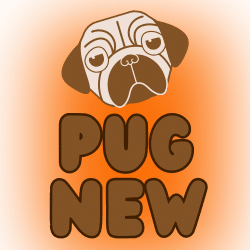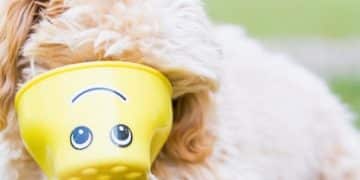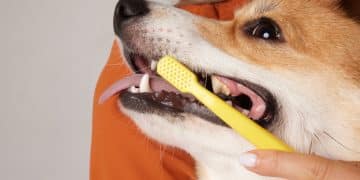Stop Destructive Chewing: 7 Tips to Protect Your Home
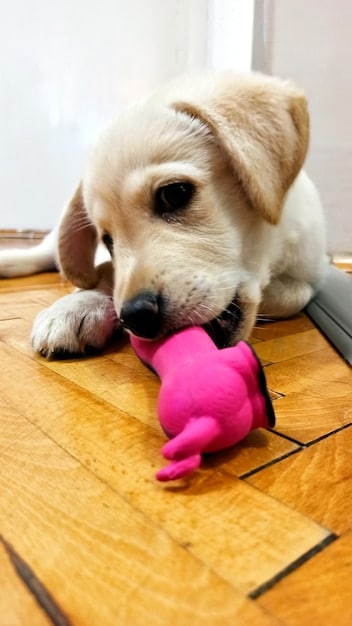
Anúncios
Destructive chewing in dogs can be frustrating for owners, but understanding the reasons behind this behavior and implementing consistent training strategies, providing appropriate chew toys, and managing their environment can effectively curb this undesirable habit and protect your furniture and sanity.
Is your furniture a chew toy? Are your shoes disappearing, only to reappear in pieces? Destructive chewing is a common problem for dog owners, but it doesn’t have to be a way of life. Understanding why your dog chews and implementing the right strategies can save your home and your sanity.
Anúncios
Understand Why Your Dog is Chewing
Before you can stop the destructive chewing, you need to understand why your dog is doing it. Chewing is a natural behavior for dogs, but excessive or destructive chewing can stem from various underlying causes. Identifying the root cause is the first step in addressing the problem effectively.
Teething Puppies
Puppies explore the world with their mouths, and chewing is a way to relieve the discomfort of teething. As their adult teeth come in, puppies experience pain and pressure in their gums, and gnawing on objects can provide relief.
Anúncios
Boredom and Anxiety
Adult dogs often chew out of boredom or anxiety. If a dog isn’t getting enough mental and physical stimulation, they may turn to chewing as a way to entertain themselves. Similarly, dogs with separation anxiety may chew when left alone as a way to cope with their distress.
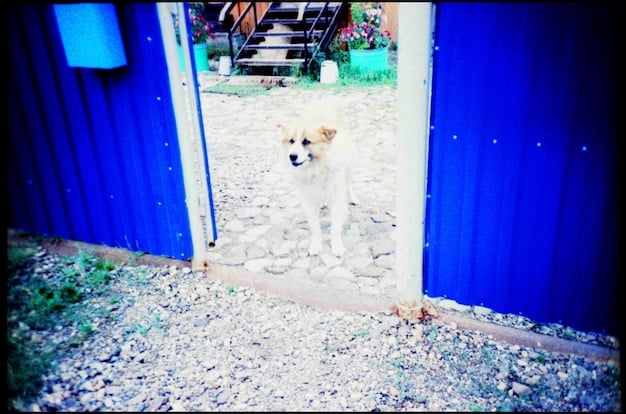
Lack of Training
Sometimes, destructive chewing is simply due to a lack of training. If a dog hasn’t been taught what is and isn’t appropriate to chew on, they may not know any better. Consistent training is essential for setting boundaries and teaching your dog acceptable chewing behaviors.
Understanding the specific reasons behind your dog’s chewing habits is crucial to implementing effective solutions. By addressing the underlying cause, you can reduce or eliminate the destructive chewing behavior and protect your belongings.
Provide Plenty of Appropriate Chew Toys
One of the most effective ways to curb destructive chewing is to provide your dog with an abundance of appropriate chew toys. These toys give your dog a safe outlet for their natural chewing instincts, redirecting their attention away from your furniture and other belongings.
- Variety is Key: Offer a variety of chew toys in different textures, shapes, and sizes. This will keep your dog interested and prevent them from getting bored with the same old toy.
- Durable Options: Choose toys that are durable and designed for heavy chewers. Look for toys made from materials like hard rubber, nylon, or rope. Always supervise your dog when they are playing with a new toy to ensure they don’t break off and swallow any pieces.
- Interactive Toys: Consider puzzle toys or treat-dispensing toys. These toys not only satisfy your dog’s chewing needs but also provide mental stimulation, which can help reduce boredom-related chewing.
Providing appropriate chew toys is a proactive step in managing your dog’s chewing behavior. By giving them safe and engaging alternatives, you can satisfy their natural instincts without sacrificing your furniture.
Increase Exercise and Mental Stimulation
Boredom and pent-up energy are major contributors to destructive chewing. Increasing your dog’s exercise and providing more mental stimulation can significantly reduce the likelihood of them turning to your belongings for entertainment.
- Daily Walks: Ensure your dog gets a daily walk or run. The amount of exercise they need will depend on their breed, age, and energy level, but aim for at least 30 minutes of vigorous activity each day.
- Playtime: Engage in interactive play sessions with your dog, such as fetch, tug-of-war, or frisbee. These activities provide physical exercise and mental stimulation, helping to tire them out and reduce boredom.
- Training Sessions: Incorporate short training sessions into your daily routine. Teaching your dog new tricks or reinforcing basic commands provides mental stimulation and strengthens your bond.
Increasing exercise and mental stimulation is a powerful way to combat destructive chewing. A tired and mentally stimulated dog is less likely to turn to your furniture for entertainment, making your home a safer and more peaceful place.
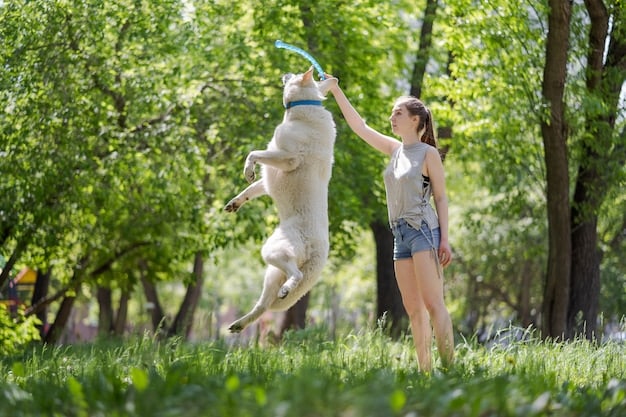
Dog-Proof Your Home
Even with appropriate chew toys and plenty of exercise, it’s crucial to dog-proof your home to protect your belongings. This involves removing or restricting access to items that your dog is likely to chew on, especially when you’re not able to supervise them.
Put Valuables Out of Reach
Store shoes, clothing, books, and other valuable items in closets, drawers, or on high shelves where your dog can’t reach them. This simple step can prevent a lot of damage and frustration.
Use Bitter Sprays
Apply bitter-tasting sprays to furniture legs, baseboards, and other surfaces that your dog is prone to chewing on. These sprays are non-toxic but have an unpleasant taste that deters most dogs from chewing.
Confine Your Dog When Unsupervised
When you’re not able to supervise your dog, confine them to a safe and dog-proofed area, such as a crate or a designated room. Provide them with plenty of chew toys and a comfortable bed to keep them occupied.
Dog-proofing your home is a practical way to protect your belongings and prevent destructive chewing. By minimizing temptation and providing a safe environment, you can reduce the likelihood of your dog engaging in unwanted chewing behaviors.
Train the “Leave It” Command
The “leave it” command is an essential tool for preventing destructive chewing. It teaches your dog to ignore or move away from an object on command, allowing you to redirect their attention and prevent them from chewing on something inappropriate.
Start with a Low-Value Item
Begin by placing a low-value item, such as a piece of kibble or a toy, on the floor. Cover it with your hand and say “leave it” in a firm but calm voice. If your dog tries to get to the item, keep your hand over it. Once they stop trying, reward them with a treat from your other hand.
Increase the Challenge
Gradually increase the challenge by using more tempting items and eventually leaving the item uncovered. If your dog attempts to take the item, say “leave it” and cover it again. Reward them when they back away.
Practice Regularly
Practice the “leave it” command regularly in various situations. This will help your dog generalize the command and respond reliably even when they are highly motivated to chew on something.
The “leave it” command is a valuable tool for preventing destructive chewing. By teaching your dog to respect this command, you can effectively redirect their attention and protect your belongings from unwanted chewing.
Address Separation Anxiety
If your dog’s destructive chewing is triggered by separation anxiety, addressing the anxiety itself is crucial. Dogs with separation anxiety often chew when left alone as a way to cope with their distress. By reducing their anxiety, you can reduce their chewing behavior.
- Desensitization: Gradually desensitize your dog to your departures and arrivals. Start by practicing short departures and returns, gradually increasing the duration of your absences.
- Create a Safe Space: Provide your dog with a comfortable and safe space, such as a crate or a designated room, where they can feel secure when you’re away. Include familiar items like their bed, toys, and a worn piece of your clothing.
- Consult a Professional: If your dog’s separation anxiety is severe, consult with a veterinarian or a certified dog trainer. They can provide additional guidance and may recommend medication or other interventions.
Addressing separation anxiety is essential for reducing destructive chewing in anxious dogs. By creating a sense of security and reducing their distress, you can help them cope with your absence and prevent them from turning to chewing as a coping mechanism.
Consistency Is Key
Consistency is essential when addressing destructive chewing. Dogs thrive on routine and clear expectations, so it’s important to be consistent with your training, rules, and boundaries. Everyone in the household should be on board with the same strategies and guidelines.
Enforce Rules Consistently
Enforce rules about what is and isn’t appropriate to chew on consistently. If your dog is caught chewing on something they shouldn’t, redirect them to an appropriate chew toy and praise them for chewing on it.
Provide a Consistent Routine
Provide your dog with a consistent daily routine, including regular feeding times, walks, playtime, and training sessions. This helps them feel secure and reduces anxiety and boredom, which can trigger destructive chewing.
Stay Patient
Be patient and understanding. It takes time and consistency to change a dog’s behavior, so don’t get discouraged if you don’t see results immediately. Celebrate small successes and keep working towards your goals.
Consistency is the cornerstone of effective behavior modification. By being consistent with your training, rules, and routine, you can create a stable and predictable environment that helps your dog overcome destructive chewing habits.
| Key Point | Brief Description |
|---|---|
| 🐾 Understand the Cause | Identify if chewing is due to teething, boredom, or anxiety. |
| 🧸 Provide Chew Toys | Offer a variety of durable and engaging chew toys. |
| 🏃 Increase Exercise | Ensure daily physical and mental stimulation. |
| 🛡️ Dog-Proof Your Home | Remove valuables and use deterrent sprays. |
FAQ
▼
Sudden chewing can be due to increased stress, boredom, or dietary changes. It’s essential to rule out medical issues with a vet visit and then address potential behavioral triggers.
▼
If chewing only happens when you’re away and is accompanied by other signs like whining or pacing, separation anxiety is likely. Consult a vet or trainer for assessment.
▼
Look for durable toys made from hard rubber or nylon. Brands like Kong and Nylabone offer options specifically designed for aggressive chewers to last longer.
▼
Puppies typically teethe from about 3 to 7 months old. Providing appropriate chew toys during this period can help alleviate their discomfort and protect your belongings.
▼
If chewing is persistent, excessive, or accompanied by other behavioral issues, consulting a professional dog trainer or veterinary behaviorist is advisable for personalized guidance.
Conclusion
Dealing with destructive chewing can be challenging, but by understanding the root causes and implementing these seven strategies, you can effectively curb this behavior and protect your home. Remember, patience, consistency, and a loving approach are key to success.
